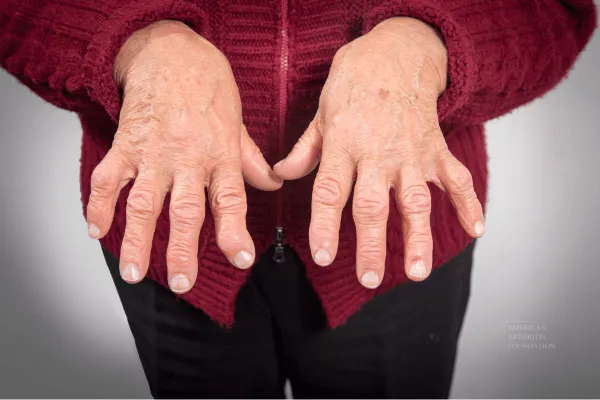About Arthritis
As the nation’s #1 cause of disability, arthritis affects nearly 60 million adults and 300,000 children. Over 100 types of arthritis and related conditions damage the joints and often other organs.
How can we assist you?
Helpful Tools for You

Rheumatoid Arthritis Linked to Increased Risk of Major Osteoporotic Fractures
Rheumatoid arthritis (RA) is well-known for its impact on joints, causing pain, swelling, and stiffness. However, a lesser-known consequence of this autoimmune condition is the increased risk of major osteoporotic fractures. A recent study found that patients with RA are nearly 40% more likely to experience these fractures compared to individuals without RA, underscoring the importance of fracture prevention strategies in managing the disease.
Understanding the Link Between RA and Fractures
RA is a chronic inflammatory condition that primarily affects the joints, but its systemic nature means that it also impacts bone health. The inflammation associated with RA can lead to bone loss, making patients more susceptible to fractures. Fragility fractures, especially in areas like the hip, spine, and wrists, are of particular concern because they can lead to long-term disability and increased mortality in older adults.
A study published in Rheumatic & Musculoskeletal Diseases Open analyzed data from the Nord-Trøndelag Health Study (HUNT) in Norway. The study included 605 patients with RA and 91,680 participants without the disease. Over the course of the study, which spanned several decades, 9,670 fractures occurred, with 88 major osteoporotic fractures recorded in the RA group. These findings highlight the significantly higher fracture risk faced by RA patients.
The Role of DMARDs in Fracture Prevention
Disease-modifying antirheumatic drugs (DMARDs), particularly biological DMARDs (bDMARDs), are commonly used to manage inflammation in RA. These drugs help reduce joint damage and slow disease progression. However, the study sought to determine whether the use of DMARDs could also help mitigate the risk of osteoporotic fractures.
The results showed that patients with RA who were treated with bDMARDs had a slightly lower risk of fractures compared to those who were not. While the evidence was not definitive, it suggests that controlling inflammation with bDMARDs may reduce fracture risk, particularly when combined with treatments that support bone health.
“Our findings showed weak evidence that the fracture risk in bDMARDs might be comparable to participants without rheumatoid arthritis, indicating that anti-inflammatory treatment and/or antiosteoporotic treatment are important for fracture prevention in this patient group,” the study authors noted.
Managing Fracture Risk in RA
Fracture prevention is an essential aspect of managing rheumatoid arthritis, especially for older adults and those with long-standing disease. The increased risk of fractures in RA patients means that early intervention is crucial. Treatment strategies should include both inflammation control and bone health management.
Antiosteoporotic medications, such as bisphosphonates, can help strengthen bones and prevent fractures in individuals at high risk. Additionally, calcium and vitamin D supplementation may support bone health in patients with RA. Regular weight-bearing exercises and physical therapy can also improve bone density and muscle strength, reducing the likelihood of falls and fractures.
The Economic Impact of Fractures in RA
Beyond the physical consequences, fractures in RA patients also carry a significant economic burden. Fragility fractures often require extensive medical intervention, rehabilitation, and long-term care, placing a strain on both patients and healthcare systems. Preventing fractures through comprehensive RA management not only improves patient outcomes but also reduces healthcare costs.
The study authors concluded, “This finding may be of importance not only for individuals with rheumatoid arthritis but also for society when considering the substantial economic burden associated with fractures.”
Conclusion
Rheumatoid arthritis increases the risk of major osteoporotic fractures by nearly 40%, making it essential for patients and healthcare providers to focus on both joint health and bone health in managing the disease. The use of DMARDs, especially bDMARDs, may help lower fracture risk, but additional strategies such as antiosteoporotic medications, supplements, and physical therapy should be considered to reduce the likelihood of fractures.
The American Arthritis Foundation encourages individuals with RA to discuss fracture prevention with their healthcare providers. By combining inflammation control with proactive bone health strategies, patients can reduce their risk of fractures and improve their overall quality of life.
Effects of Arthritis

Cause of Disability
In the United States, 23% of all adults, or more than 54 million people, have arthritis. It is a leading cause of work disability, with annual costs for medical care and lost earnings of $303.5 billion.

Workforce Effects
Sixty percent of US adults with arthritis are of working age (18 to 64 years). Arthritis can limit the type of work they are able to do or keep them from working at all.

Global Impact
In fact, 8 million working-age adults report that their ability to work is limited because of their arthritis. For example, they may have a hard time climbing stairs or walking from a parking deck to their workplace.
Promoting Interventions That Reduce Arthritis Pain
American Arthritis Foundation recognizes several proven approaches to reduce arthritis symptoms:
Be active. Physical activity—such as walking, bicycling, and swimming—decreases arthritis pain and improves function, mood, and quality of life. Adults with arthritis should move more and sit less throughout the day. Getting at least 150 minutes of moderate-intensity physical activity each week is recommended.
Protect your joints. People can help prevent osteoarthritis by avoiding activities that are more likely to cause joint injuries.
Talk with a doctor. Recommendations from health care providers can motivate people to be physically active and join a self-management education program. Should your arthritis be interfering with your activities of daily living you may be a candidate to receive many new treatments, and learn how to reverse the arthritis condition.


